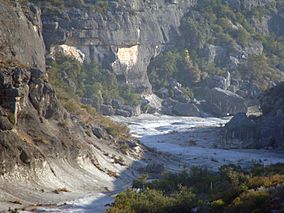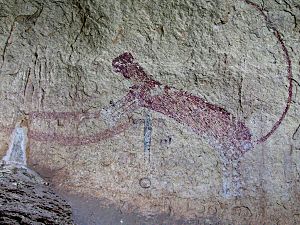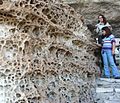Seminole Canyon State Park and Historic Site facts for kids
Quick facts for kids Seminole Canyon State Park and Historic Site |
|
|---|---|
 |
|
| Location | Val Verde County, USA |
| Nearest city | Comstock, Texas |
| Area | 2,172.5 acres (879.2 ha) |
| Established | 1980 |
| Visitors | 27,227 (in 2022) |
| Governing body | Texas Parks and Wildlife Department |
|
Seminole Canyon Archeological District
|
|
|
U.S. National Historic Landmark District
Contributing Property |
|
| Location | Address restricted |
| Area | 1,334.4 acres (540.0 ha) |
| Part of | Portions included in Lower Pecos Canyonlands Archeological District (ID100006256) |
| NRHP reference No. | 71000967 |
| Significant dates | |
| Added to NRHP | January 25, 1971 |
| Designated NHLDCP | January 13, 2021 |
Seminole Canyon State Park and Historic Site is an exciting state park in Texas, USA. You can find it off U.S. Route 90, about 9 miles west of Comstock in Val Verde County. This park is a fantastic spot for camping, biking, watching birds, hiking, and learning about ancient history. Inside the park, you can see amazing cave art and old tools from people who lived here thousands of years ago. This special park is part of the larger Seminole Canyon Archeological District, which is listed on the National Register of Historic Places.
Contents
A Look Back in Time: Park History
Seminole Canyon State Park and Historic Site covers a huge area of about 2,172 acres. The Texas Parks and Wildlife Department manages this incredible place. It's located in Val Verde County and is easy to reach from U.S. Route 90. The park is also right next to the Amistad National Recreation Area.
Ancient Life in the Canyon
Scientists believe that people first lived here about 10,000 years ago! This was during the Holocene era, a time when giant animals like mammoths also roamed the land. Back then, the area likely had many more plants, which helped support all the wildlife. Over thousands of years, wind and water have carved out the canyon walls, creating the beautiful rock formations you see today. The first people started leaving their amazing cave art here between 2,000 and 8,000 years ago.
European Explorers and Scouts
In 1591, a Spanish explorer named Gaspar Castaño de Sosa might have been the first European to visit this area. He was traveling along the Rio Grande and Pecos River to explore New Mexico. Much later, in the 1800s, brave soldiers called the Black Seminole Scouts of the United States Army were stationed here. They gave the region its name, Seminole Canyon. The Southern Pacific Railroad built tracks through the area in 1882.
Becoming a Protected Park
In 1971, a large part of the area, about 13,344 acres, was recognized as the Seminole Canyon Archeological District. It was added to the National Register of Historic Places. Later, in 1985, even more land was added to this important historical listing. The Texas Parks and Wildlife Department bought the land for the park in two steps. They bought 1,500 acres in 1974 and another 700 acres in 1977. Finally, Seminole Canyon State Park opened its doors to visitors in 1980.
Amazing Rock Art: Stories on Stone
The park is famous for its ancient rock paintings, which are in a style called Pecos River Style. You can take tours of the Fate Bell Shelter, led by volunteers from the Rock Art Foundation.
Panther Cave: A Leaping Cat
You can see Panther Cave from a distance on a hiking trail or by taking a boat from the National Park Service dock in Amistad National Recreation Area. The cave gets its name from a painting of a huge, leaping panther! Some of the art in this cave is super old, dating back about 7,000 years. You'll see many big cat themes in the art, including drawings of people wearing cat-ear head decorations.
Fate Bell Shelter: Ancient Discoveries
Fate Bell Shelter is named after Mr. Fayette Bell, who once owned the land. Archeologists first explored this cave in 1932 and again in 1963. The cave art and old tools found here are thought to be some of the oldest in all of North America! Guided tours of Fate Bell Shelter are available Wednesday through Sunday. During very hot weather, the tour hours might be shorter.
Fun Things to Do and See
Right outside the Visitors Center, you'll see a tall, 17-foot bronze statue called The Maker of Peace. It was created by a Texas artist named Bill Worrell in 1994.
Bird Watching Adventures
Seminole Canyon State Park and the nearby Amistad National Recreation Area are perfect for bird watching. Many different kinds of birds live here, including canyon birds, desert birds, and birds that love to eat seeds. Bring your binoculars!
Hiking and Biking Trails
The park has nine miles of trails that are great for hiking and mountain biking. If you want to explore the canyons and Fate Bell Shelter, you can only do so on a guided tour.
Camping and Facilities
The park has restrooms with showers, which is handy after a day of exploring. You can choose from different types of campsites. Some are very simple with no hookups, while others have water, or both water and electricity. There's also a place to dump waste from trailers. You can even find wireless Internet (Wi-Fi) in some parts of the park.
Visiting the Park
Seminole Canyon State Park and Historic Site is open every day of the week. Visitors need to pay an entrance fee to get in. If you're coming with a school group, make sure to arrange your tour in advance.
Images for kids
-
Pictograph in rock shelter
More to Explore








